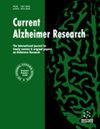16周的有氧运动不会改变阿尔茨海默病患者楔前叶的静息状态连接。
IF 1.8
4区 医学
Q3 CLINICAL NEUROLOGY
引用次数: 0
摘要
引言在健康的老年人和轻度认知障碍患者中,体育锻炼可以增加通过静息态功能磁共振成像(rs-fMRI)测量的默认模式网络(DMN)中的大脑功能连接。然而,到目前为止,还没有研究调查体育锻炼对阿尔茨海默病(AD)患者DMN功能静息状态连接的影响。目的在一项单盲随机对照试验中,我们使用rs-fMRI评估了16周体育锻炼的有氧运动干预对AD患者DMN连接的影响。方法将五名患者随机分为对照组或运动组。运动组每周进行三次60分钟的有氧运动,持续16周。所有患者在3T、基线和16周后均接受了全脑rs fMRI检查。由于后扣带皮层(PCC)和相邻的楔前叶构成DMN的中心枢纽,该顶叶区域被定义为兴趣区域,并被用作将年龄和性别视为协变量的rs fMRI数据的功能连接分析的种子区域。结果无论是基于种子的分析,还是基于ICA的分析,重点关注DMN网络的组成部分,都显示了从基线到随访的任何运动诱导的功能静息状态连接的变化。结论16周的有氧运动不会改变AD患者的PCC/楔前叶区域的功能连接。可能需要更长时间的干预来显示运动对大脑连接的影响。本文章由计算机程序翻译,如有差异,请以英文原文为准。
Sixteen weeks of aerobic exercise does not alter resting-state connectivity of the precuneus in patients with Alzheimer's disease.
INTRODUCTION
In healthy elderly persons and patients with mild cognitive impairment, physical exercise can increase functional brain connectivity in the default mode network (DMN) measured by restingstate functional magnetic resonance imaging (rs-fMRI). However, no studies have so far investigated the effect of physical exercise on functional resting-state connectivity in the DMN in patients with Alzheimer's disease (AD).
OBJECTIVE
In a single-blinded randomized controlled trial, we assessed the effects of an aerobic exercise intervention of 16 weeks of physical exercise on DMN connectivity using rs-fMRI in patients with AD.
METHODS
Forty-five patients were randomly assigned to either a control or exercise group. The exercise group performed 60-min of aerobic exercise three times per week for 16 weeks. All the patients underwent whole-brain rs-fMRI at 3 T, at baseline, and after 16 weeks. Since the posterior cingulate cortex (PCC) and adjacent precuneus constitute a central hub of the DMN, this parietal region was defined as region-ofinterest and used as the seed region for functional connectivity analysis of the rs-fMRI data treating age and gender as covariates.
RESULTS
Neither seed-based analysis, seeded in the PCC/precuneus region nor ICA-based analyses, focusing on components of the DMN network, showed any exercise-induced changes in functional resting-state connectivity from baseline to follow-up.
CONCLUSION
16 weeks of aerobic exercise does not modify functional connectivity of the PCC/precuneus region in patients with AD. A longer intervention may be needed to show the effect of exercise on brain connectivity.
求助全文
通过发布文献求助,成功后即可免费获取论文全文。
去求助
来源期刊

Current Alzheimer research
医学-神经科学
CiteScore
4.00
自引率
4.80%
发文量
64
审稿时长
4-8 weeks
期刊介绍:
Current Alzheimer Research publishes peer-reviewed frontier review, research, drug clinical trial studies and letter articles on all areas of Alzheimer’s disease. This multidisciplinary journal will help in understanding the neurobiology, genetics, pathogenesis, and treatment strategies of Alzheimer’s disease. The journal publishes objective reviews written by experts and leaders actively engaged in research using cellular, molecular, and animal models. The journal also covers original articles on recent research in fast emerging areas of molecular diagnostics, brain imaging, drug development and discovery, and clinical aspects of Alzheimer’s disease. Manuscripts are encouraged that relate to the synergistic mechanism of Alzheimer''s disease with other dementia and neurodegenerative disorders. Book reviews, meeting reports and letters-to-the-editor are also published. The journal is essential reading for researchers, educators and physicians with interest in age-related dementia and Alzheimer’s disease. Current Alzheimer Research provides a comprehensive ''bird''s-eye view'' of the current state of Alzheimer''s research for neuroscientists, clinicians, health science planners, granting, caregivers and families of this devastating disease.
 求助内容:
求助内容: 应助结果提醒方式:
应助结果提醒方式:


